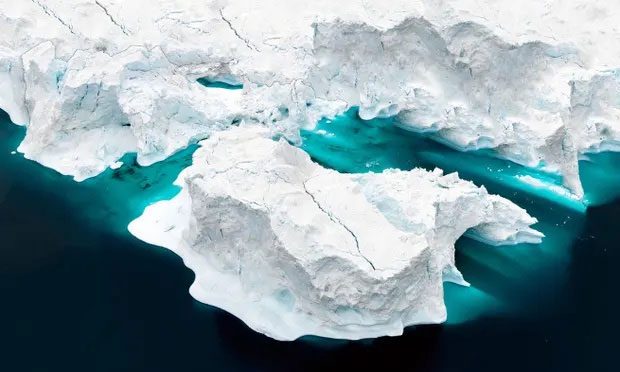A study reveals that the ice sheet in Greenland is losing an average of 30 million tons of ice every hour due to the climate crisis, which is over 20% more than previously estimated.
According to The Guardian, the research published in the journal Nature utilized artificial intelligence techniques to map over 235,000 endpoints of various glaciers over a period of 38 years. The results indicated that the Greenland ice sheet has lost approximately 5,000 km² of area at its edges since 1985, equating to one trillion tons of ice lost from 1985 to 2022.
The most recent update from the project that reconciles all other measurements of ice in Greenland shows that 221 billion tons of ice have been lost each year since 2003. The new study also indicates that Greenland loses 43 billion tons of ice each year, resulting in an average loss of approximately 30 million tons per hour.

Greenland loses 43 billion tons of ice each year. (Photo: Getty Images).
Some scientists are concerned that the influx of freshwater into the North Atlantic could mean a reduction in a current known as the Atlantic Meridional Overturning Circulation (AMOC), leading to severe consequences for humanity.
The significant loss of ice in Greenland is attributed to record-high global temperatures over recent decades. The techniques used so far, such as measuring ice thickness or weight through gravity data, have been useful in determining the amount of ice lost to the ocean and contributing to rising sea levels.
However, scientists have been unable to explain the shrinkage of glaciers that are primarily located below sea level in the narrow bays around the island.
Dr. Chad Greene, a researcher at NASA’s Jet Propulsion Laboratory and the lead author of the study, stated: “The changes surrounding Greenland are immense and are occurring everywhere. Almost all glaciers have melted in the past few decades. If the melting ice causes freshwater to flow into the North Atlantic, then the AMOC will weaken.”
The AMOC is known to be at its weakest in 1,600 years. In 2021, researchers detected warning signs of a tipping point in climate change. A recent study suggests that the AMOC current could collapse as early as 2025 in a worst-case scenario. A significant portion of the Greenland ice sheet is also believed by scientists to be approaching the tipping point of irreversible melting, with an amount of ice correlating to projected sea-level rises of 1 to 2 meters.
Scientists have noted: “There are concerns that any influx of freshwater could act as a ‘tipping point,’ potentially causing the Atlantic current to collapse, disrupting weather patterns, ecosystems, and global food security. However, currently, the freshwater from the glaciers in Greenland is not incorporated into oceanographic models. The less dense freshwater entering the sea also slows down the normal process of heavier saltwater sinking in polar regions, promoting the collapse of the AMOC current system.”
Professor Tim Lenton from the University of Exeter in the UK, who was not involved in the study, stated that the influx of freshwater into the North Atlantic is concerning, particularly regarding the formation of deep water in the Labrador and Irminger Seas within the subpolar current. Other evidence suggests these areas are at the highest risk of transitioning into a state of collapse.
“That would resemble a partial collapse of the AMOC, but occurring more rapidly and having profound impacts on the UK, Western Europe, parts of North America, and the Sahel region, where the West African monsoon could be severely disrupted.”
Dr. Greene believes that detecting the loss of ice is crucial in calculating Earth’s energy imbalance—meaning how much additional heat the Earth absorbs from the Sun due to greenhouse gas emissions caused by humans.
“It takes a lot of energy to melt one trillion tons of ice. Therefore, if we want to have accurate energy balance models for Earth, this must be taken into account,” he said.



















































